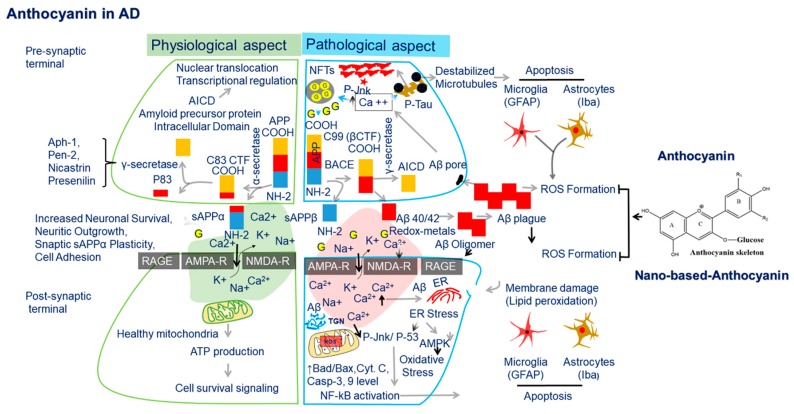Figure 2.
The schematic representation of physiological and pathological aspects (major sources of oxidative stress) in Alzheimer’s disease (AD) and their corresponding antioxidant defense approach by anthocyanin in cholinergic neurons. Mitochondrial abnormalities, advanced glycation end products (RAGE), redox-active metals (iron, copper and zinc), amyloid beta (Aβ) deposition, and alterations in cell signaling pathways are major sources of Oxidative stress (OxS) in AD. In an amyloidogenic pathway, the generated neurotoxic Aβ40/42 peptides from integral membrane protein Amyloid precursor Protein (APP) after sequential cleavage by β and γ-secretase is aggregated and formed oligomers before plaque (extracellularly) and neurofibrillary tangles (intracellularly) formation. This results in the disruption of calcium homeostasis, blocked ion channels, mitochondrial dysfunction impairment of energy metabolism, and glial cell activation that ultimately leads to oxidative stress resulting in neuronal cell death. In contrast, in a non-amyloidogenic pathway, APP is initially cleaved by α-secretase followed by further cleavage by γ-secretase excluding the possibility of Aβ generation and thus ROS production. Anthocyanin inhibited generated oxidative stress (OxS) in AD providing a neuro-protective effect. Abbreviations. BACE1, beta-site APP cleaving enzyme 1; βCTF, Beta site intracellular carboxyl terminal fragment; AICD, amyloid intracellular domain; APP, Amyloid precursor protein, GFAP, Glial fibrillary acidic protein, Iba-1, ionized calcium adaptor binding molecule 1, NF-κB, Nuclear factor-κB, p- JNK, phospo c-Jun N-terminal Kinase.

